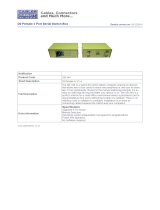
Pelco Manual C538M-A (3/04) 11
3.3 SETUP
3.3.1 Preliminary Discussion
FRAME ADDRESSES
The IRC, VCRC, and the CM9760-REL Relay Interface Unit, all use software GPIs
to activate control of external devices.
The number of GPIs required by each hardware device varies. The number of GPIs
(General Purpose Interfaces) required by the REL is eight.
The address setting entered into the DIP switches, however, is based on what is
called a frame address.
There is a direct numerical relationship between GPIs and frame addressing, which
is as follows:
THE USE OF 32 GPIs SPANS ONE FRAME ADDRESS, REGARDLESS OF DE-
VICE TYPE USED (device types other than REL units also utilize GPI control).
Therefore a single REL, which uses eight GPIs, occupies only 1/4 of a frame ad-
dress (refer to Figure 8).
This means that four relay units fit into one frame address space. To uniquely iden-
tify and address REL units within this frame address space, two additional address
bits (sub-frame bits) are used (refer to Figure 10).
The frame address entered in the DIP switch for the REL (or any other device)
serves as a STARTING point for the frame address space it needs. Once a starting
frame address is entered, the REL can be thought of as allocating for itself the next
eight GPIs or the equivalent 1/4 frame address space it needs to operate. The REL,
of course, is unique in that when you have any grouping of REL units totaling four or
less, they will all more than likely share the SAME FRAME ADDRESS, and differ
only in their SUB-FRAME address bit settings.
ADDITIONAL REMARKS REGARDING FRAME ADDRESSES AND GPIs
One frame address is equivalent to the use of 32 GPIs. With a total of only 700 GPIs
available, only 700/32 or 21.8 (rounded up to 22) frame addresses are needed.
Frame addressing starts at “0”, so frame addressing runs from 0 to 21, or 22 total.
The layout of all 22 frame addresses and corresponding GPI ranges can be found
in Table A.
THE RELAY INTERFACE MEMORY FUNCTION
SW3 DIP switch settings (SW3-3 through SW3-6) control what can be thought of
as the contact “memory” function for the REL unit.
One would normally expect that when power is cycled (via a power failure or front
panel reset) that the relay contacts would return to their default settings, which for
the REL, would be determined by the normally open, normally closed (N/O, N/C)
settings entered into DIP switch 2 (SW2-7 through SW2-10).
The additional DIP switch settings for the memory function allow you to override the
default setting in the event power is cycled. With a switch setting of “1” (memory
enabled), the contacts (in groups of 16) will retain the contact setting they had at
the time power was cycled. For groups not enabled, the contacts will defer to their
default values (per DIP switch 2 settings) if power is cycled (refer to Figure 10).
NOTE:
At present, 700 GPIs are
available per system node. This
limit must be kept in mind when
configuring cascaded systems.
Some devices utilize more GPIs
and therefore more Frame Address
Space than other devices.
NOTE:
Only one device type at a
time can utilize the same frame
start address.
Figure 8. Relationship of Frame
Address Space and
the Relay Interface
Unit























